Hi everyone, it’s Nazia here from Food And Meal. As some of you know, I love exploring cuisine from around the world and putting my own spin on classic dishes. Lately I’ve been infatuated with Japanese hot pot recipes and came up with this Japanese Seafood Hot Pot that I can’t get enough of!
Hot pot is such a fun, interactive meal that brings people together through good food and conversation. The variety of seafood and vegetables cooking in the simmering broth keeps everyone engaged and waiting for their next favorite morsel.
In my Japanese-inspired hot pot, I use a savory dashi and soy sauce broth seasoned with sake, ginger and garlic. It’s packed with umami flavor that seeps into the prawns, scallops, fish and veggies as they cook. I love the sweet and salty notes the broth takes on.
The seafood cooks up tender and succulent while soaking up all that tasty broth. I also can’t resist dipping the ingredients in ponzu, sesame sauce, and chili oil as I eat. Every bite is so satisfying!
I hope my Japanese Seafood Hot Pot inspires you to gather friends around the table for some cooking and bonding. Let me know if you have a favorite hot pot recipe to share!
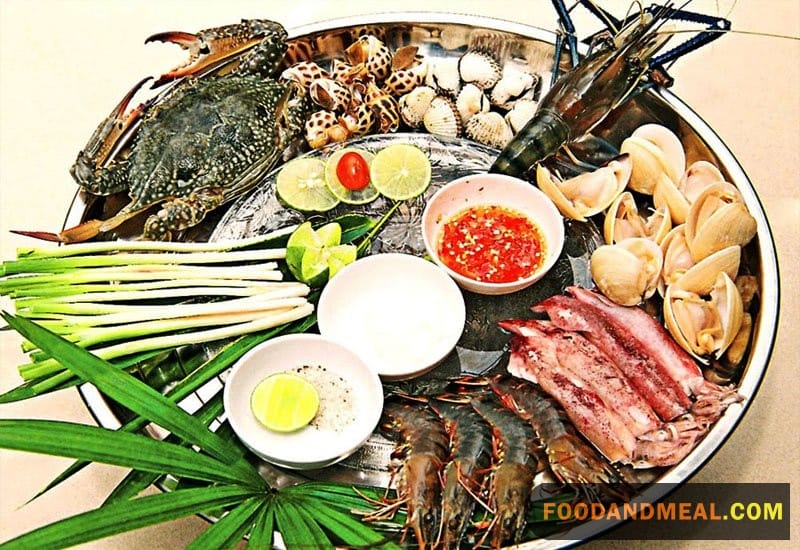
Japanese Seafood Hot Pot Recipe
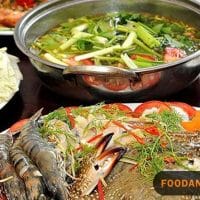
Japanese Seafood Hot Pot
Ingredients
- 1 1⁄2 quarts of water, filtered
- 1 pc. of kombu kelp for the dashi stock
- 1 teaspoon of stock powder, bonito
- 1 3⁄4 fl. oz of mirin
- 1 teaspoon of salt, sea
- 1 3⁄4 fl. oz. of sake
- 1 tablespoon of soy sauce, reduced sodium
- 1⁄4 head of cabbage, Napa
- 4 mushrooms, shiitake
- 2 mushrooms, enoki
- 1 pkt. of mushrooms, Maitake or desired type
- 1 leaf of mizuna
- 4 scallops, boiled
- 8 prawns
- 10 oysters
- 2 salmon fillets
- 2 cod fillets
- 1 thigh, chicken
- 1 block of tofu
Instructions
- Combine kombu and water in pot. Add ingredients and place pot over med heat.
- Peel shells of prawns and leave tails. Rinse thoroughly. Rinse oysters, too. Drain.
- Slice cabbage into 1” pieces.
- Place cabbage into pot started in step 1 above. Cover. Simmer on med. heat till the cabbage has wilted.
- Cut mushrooms and chicken in bite sized pieces. Rinse scallops. Cut salmon and cod in three portions each.
- When cabbage becomes tender, add scallops. Cover pot. Cook completely through.
- Place tofu and mushrooms around outside of pot. Arrange prawns, oysters, salmon and cod in middle. Simmer for 3-5 minutes. Skim off scum, if any.
- Turn heat off. Add mizuna leaves.
- Provide guests with skewers so they can cook their own chicken pieces in the hot broth. Allow them to ladle their own soup portions into their bowls, too.
Video
Notes
-
- Taste Test: Always remember to taste your broth as it simmers. Each ingredient adds a unique touch, and balancing them is an art. Done right, you're in for a mesmerizing experience! Loved the journey? Share this recipe and subscribe to our blog for more culinary adventures!
- Ingredient Quality: Opting for fresh seafood is crucial. It's not just about the dish; it's about honoring the tradition. So, take that extra step, find the freshest catch, and let your pot sing the songs of the ocean. Impressed by the depth of flavors? Spread the love - share the recipe and join our community by subscribing!
- Serving Suggestion: The essence of a hot pot is in sharing. Serve it straight from the stove, letting everyone dive into the flavors and bond over the warmth. Feeling the warmth? Share the joy of this recipe with friends and ensure you're subscribed for more heartfelt recipes!
Nutrition
© Food And Meal
This website provides approximate nutrition information for convenience and as a courtesy only. Nutrition data is gathered primarily from the Spoonacular Database, whenever available, or otherwise other online calculators.
Japanese Seafood Hot Pot: Pressure Cooker Version
Prepare your ingredients by cleaning and slicing the seafood, cutting chicken into strips, and chopping cabbage. In your pressure cooker, layer dashi, soy sauce, mirin, and sake. Add ingredients sequentially, starting with longer-cooking items. Cook under high pressure for 15 minutes, allowing flavors to meld rapidly. Release pressure, serve in bowls, and enjoy the rich melding of flavors in this delightful dish, complemented by a side of ponzu dipping sauce.
Cooking Tips
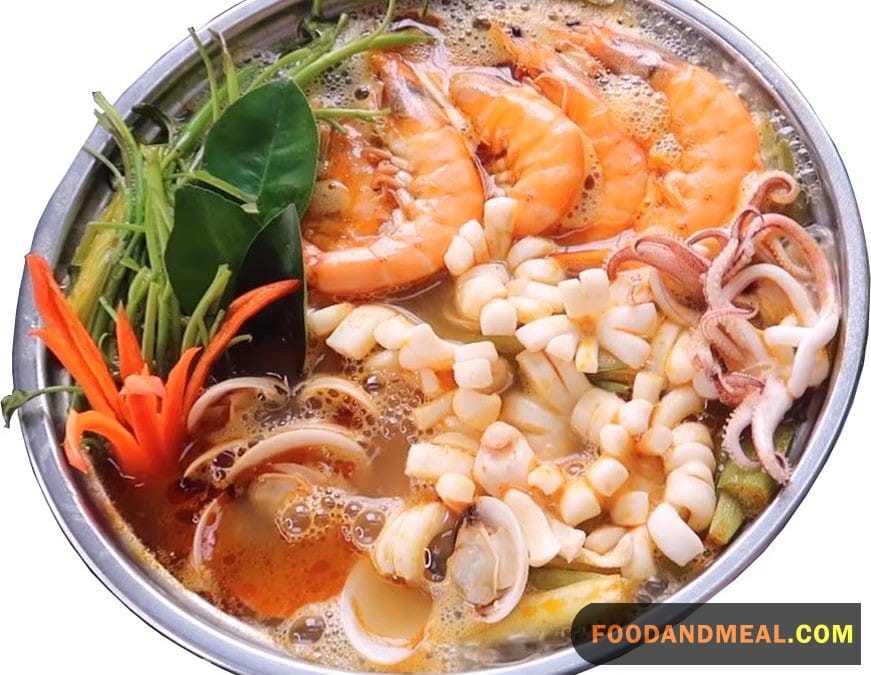
When prepping the seafood, I like to use a variety – juicy prawns, tender scallops, flaky white fish, and plump mussels work nicely. Make sure to thoroughly rinse the seafood before cooking. For extra flavor, try marinating the seafood in soy sauce, mirin and ginger first.
Part of the fun is gathering with friends, cooking the ingredients to perfection, and dipping to your heart’s content in the ponzu, raya and chili oil. The dashi broth takes on so much more flavor as you cook.
Hot pot brings me so much joy in sharing precious memories over good food. I feel happy and grateful when my friends and family enjoy this dish together.
Serving Suggestions
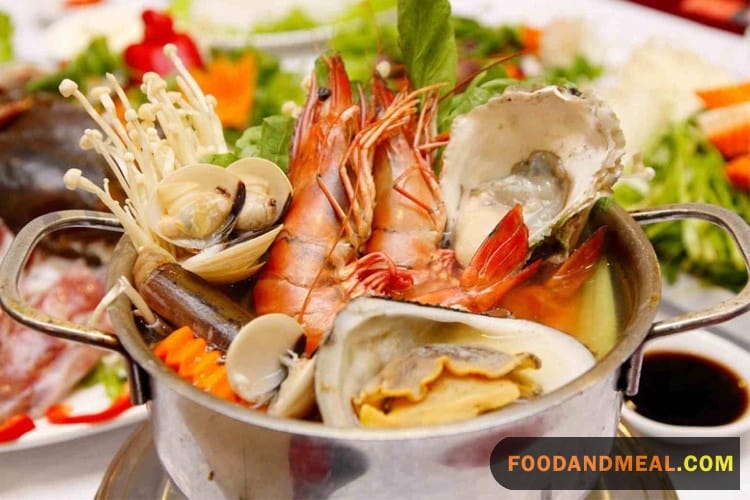
Embark on a delightful culinary journey with the enchanting Japanese Seafood Hot Pot, a dish that awakens the senses and transports you to a realm of exquisite flavors. The Seafood Miso Ramen introduces a comforting warmth, while the Teriyaki Salmon delights with its tender, teriyaki-kissed goodness. Wok Fried Crab adds a crispy touch, and the Soy Dipping Sauce provides a gentle invitation to customize each bite. The Vegetable Maki, with its refreshing crunch, complements the seafood symphony, creating a harmonious dance of textures and tastes. This experience is a heartfelt celebration of the sea’s bounty, where every ingredient contributes to a mosaic of culinary joy.
5 FAQs of Japanese Seafood Hot Pot
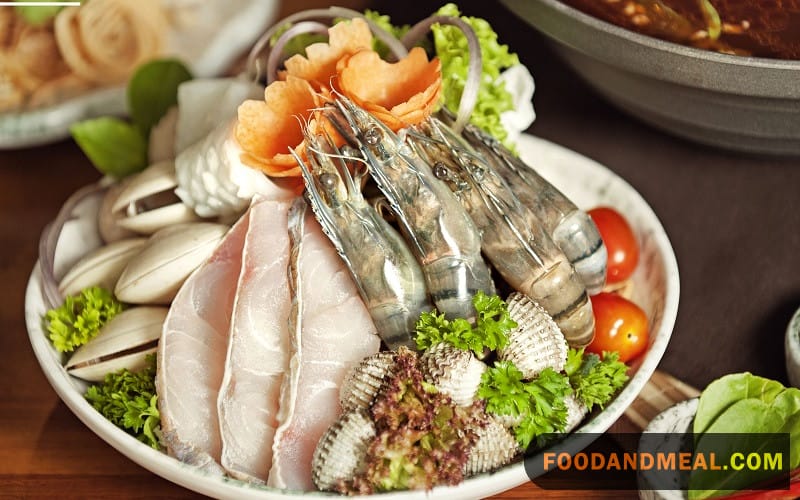
- Can I use other types of fish in the Hot Pot?
Absolutely! While white fish fillet is recommended, feel free to experiment with salmon or even squid. Adjust cooking times accordingly. - How long does the leftover Hot Pot last in the fridge?
You can store leftovers in an airtight container in the refrigerator for up to two days. However, it’s best enjoyed fresh. - Can I freeze the Hot Pot?
It’s not advisable to freeze due to the varied textures, especially the seafood, which might turn rubbery upon reheating. - What if I can’t find harusame noodles?
You can substitute with glass noodles or thin rice noodles. Adjust cooking time based on the noodle’s packaging instructions. - Is there a vegetarian version of the Seafood Hot Pot?
Of course! Substitute seafood with tofu, assorted veggies, and use a vegetable broth in place of dashi.
Dive into the rich world of Japanese Seafood Hot Pot! This easy-to-follow guide will leave your taste buds craving more. Discover the recipe now!
Hi! I'm Nazia of ‘Nazia Cooks’, a self-taught baker and cook residing in Chennai. Rooted in the rich South Indian culinary landscape, my palate has expanded to embrace global flavors. I revel in crafting fusion dishes, melding traditions to birth unique tastes.



